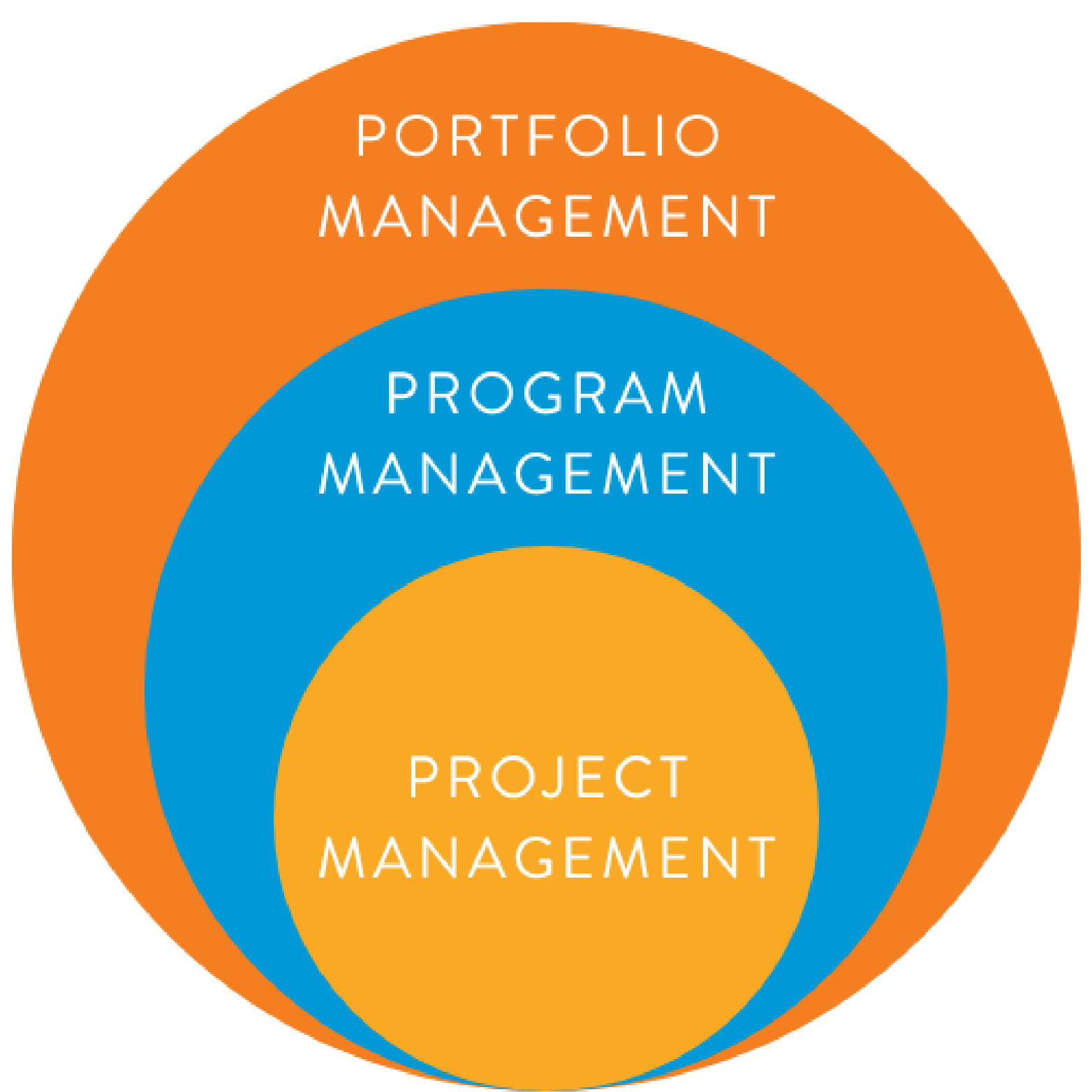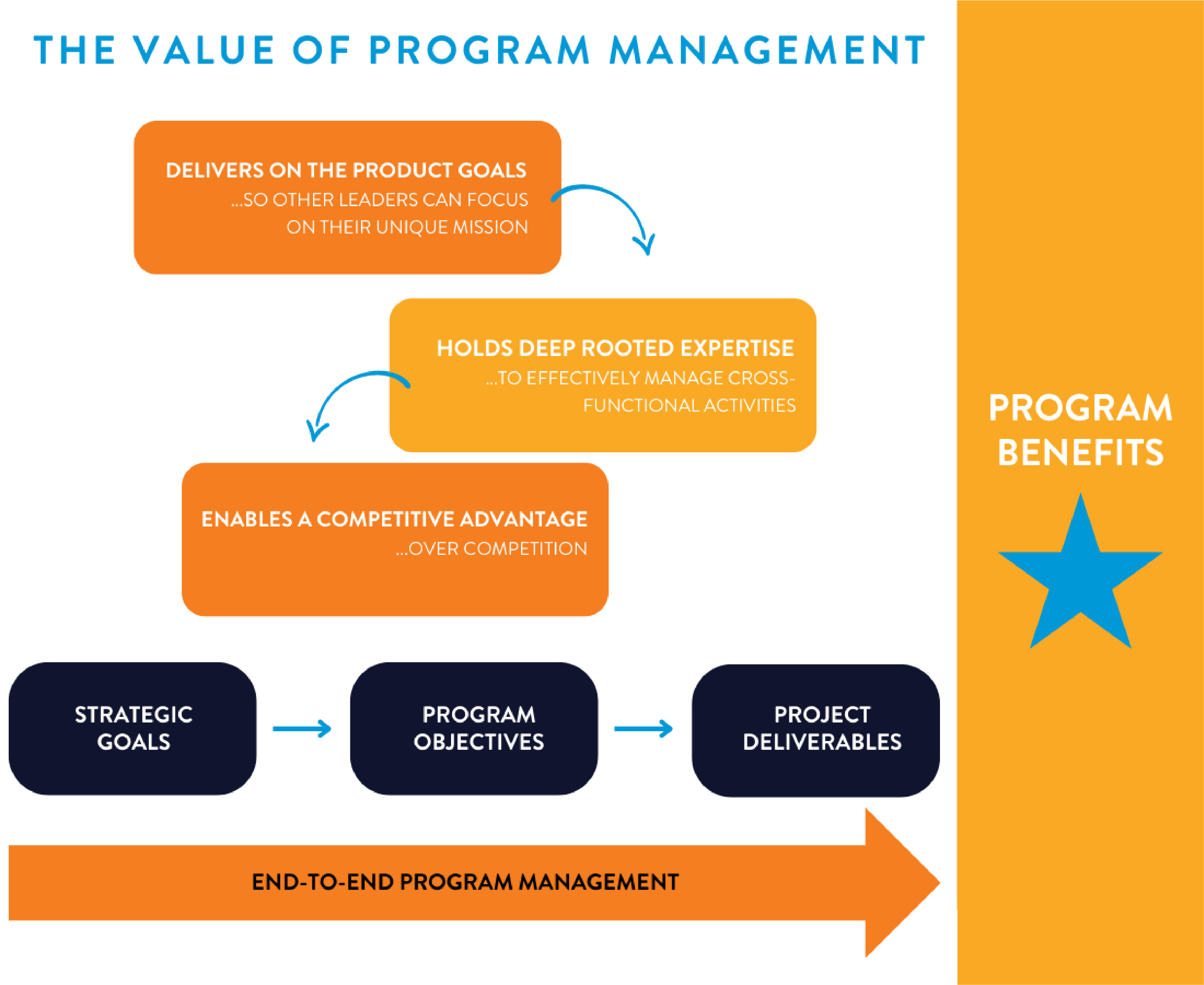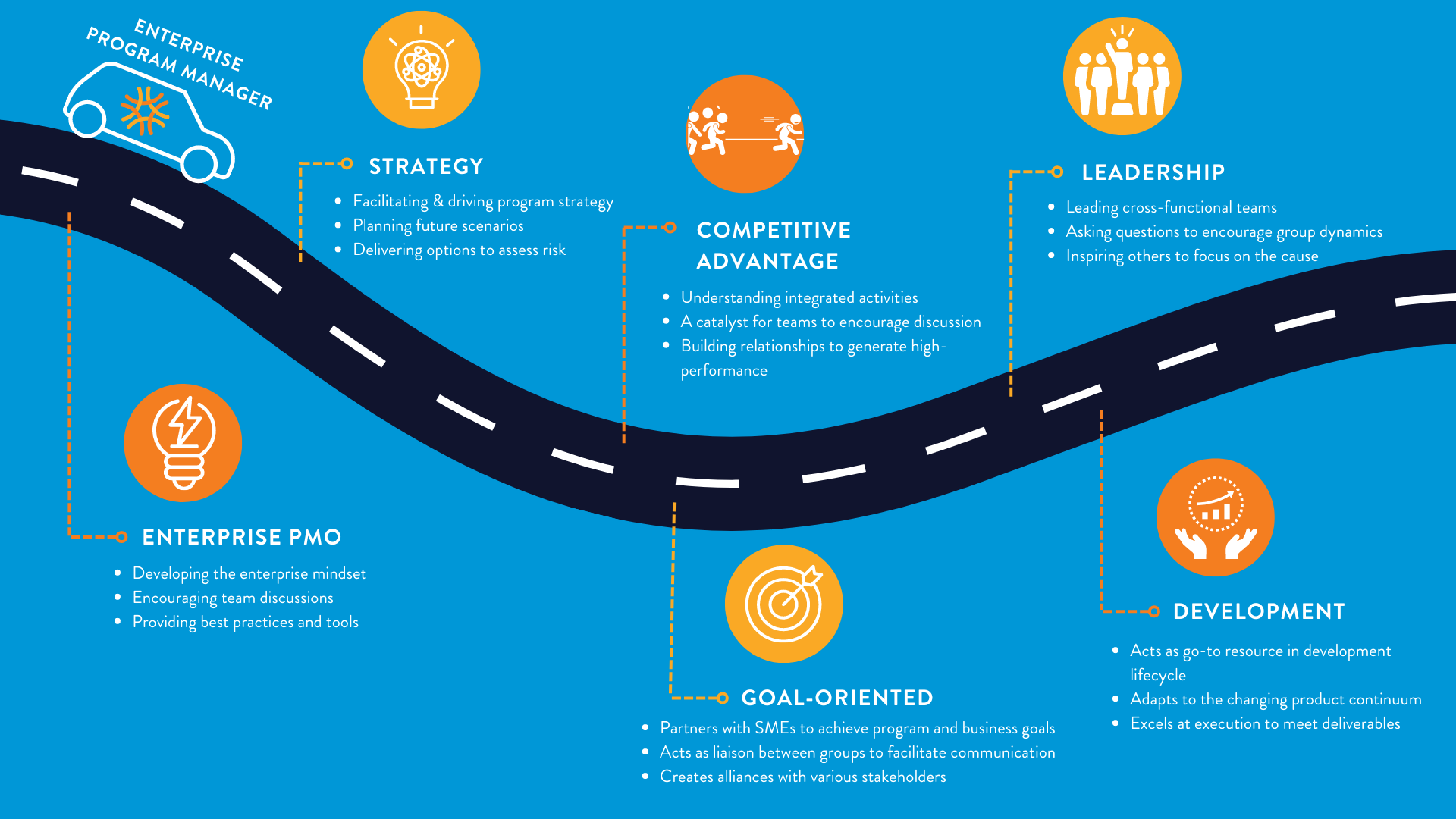Why Program Management is the Key to Success for Life Science Companies
Delivering value with enterprise program management.
Hiring the right employees is a challenge for any business, but especially for the bio/pharmaceutical industry. Many organizations prioritize hiring technical roles rather than for project, program, and portfolio management. Project, program, and portfolio management roles are distinct roles that provide unique perspectives and value to a company but are often lumped together or forgotten because organizations overlook the value of these roles. This is especially true for smaller, newer life science companies that have limited funds and resources. They often see the aforementioned roles as operational or administrative and think of them as an accessory rather than a necessity. Supportive and coordinating functions—such as project, program, and portfolio management—add efficiencies and structured processes that enable technical team members to focus on their product development milestones.
In particular, an experienced program manager brings deep experience and valuable skills to support life science companies in achieving their goals in an efficient way. They strategize and lead, build and execute development plans, provide tools and templates to facilitate workflows, and utilize effective team management techniques throughout all stages of a company’s product and portfolio development. The program manager serves an essential role for both technical and management teams because they deeply understand the criteria that deliver improved outcomes for the organization. They evaluate integrated activities, understand risks and potential pitfalls to the critical path, continuously improve processes to find effective solutions, and build morale among teams.
The program manager role is also a continuum, often evolving to become a portfolio and enterprise-wide program management role as a program moves from its early stages in a research laboratory to market approval and beyond. However, there are often misunderstandings around the value that a program manager can bring to a company and how this role is differentiated from other roles.
This article will cover the value and specifics of the role, how to build the program management function into a business model, and how it offers life science companies a competitive edge.
The role of the program manager
A program is a group of related projects managed in a coordinated way to obtain benefits and control not available from managing them individually.1 In the world of drug development, a program generally refers to all the different projects being performed to bring a drug from discovery to a particular milestone (e.g., first-in-human dosing, approval, etc.). Later in development (e.g., post-approval) or at larger companies, a program may be a more specific set of projects, such as pharmacovigilance and signal management.
The program manager is responsible for ensuring all program activities are coordinated and communicated to stakeholders, and multiple project managers often report directly or indirectly on a particular program. The program manager oversees multiple projects, focuses on the benefits that will be provided to the stakeholders, and successfully fulfills program needs through a thoughtful, well-crafted program design.1 The program manager is vital in ensuring programs are aligned with an organization’s strategic vision and goals.
To manage a program successfully, the program manager:
- Influences the completion of the various planned program activities and projects
- Manages stakeholders through effective communication and problem-solving
- Adjusts plans, strategy, or components of the program with the goal of maximizing the value and intended benefits
As described by the Project Management Institute: “Balancing these needs requires that program managers be competent in providing an integrated view of how the outputs and outcomes of program components will support the program’s intended delivery of organizational benefits.”1 A program manager must exhibit the expertise required to manage a program based on the complexity and uncertainty associated with the outcomes or the organization’s environment. The skills required may vary among programs, but essential technical and business skills are critical to the management of the program challenges.
The role is very different from that of a project manager. A project refers to a temporary endeavor undertaken to create a single, unique output or service.1 The project manager is the person responsible for making sure the project runs smoothly, is completed on time and within budget, and the status of the project is communicated to all stakeholders including the program manager.
The role of a program manager also differs from that of a portfolio manager. A portfolio is a collection of projects, programs, and other business activities that are grouped together for specific strategic objectives.1 The portfolio manager is responsible for the coordination and alignment of the portfolio with the overall corporate objectives. The program manager coordinates the activities of a program’s components to obtain benefits that are not obtained if they are managed individually. Oftentimes, the program manager is accountable directly or indirectly to the portfolio manager if one exists.
©Halloran Consulting Group, Inc. via Canva.com. This image shows the relationship between project, program, and portfolio management.

Is program management essential?
There are certain team dynamics that can drive the need and value for the role of a program manager, and they often revolve around people, processes, and communication. Here are key questions to help arrive at the right discussion points that may enable organizations to be open about the role of a program manager:
- Is your company experiencing any challenges when it comes to people, processes, or communication?
- Does your company struggle with unclear objectives, lack of transparency, unrealistic expectations, misalignment, poor resource planning, lack of risk management, lack of follow-up or follow-through, or communication missteps?
- Do you need help with the strategic positioning of an asset or the company as a whole?
- Do your initiatives involve an enterprise-wide complex program or several projects with various outcomes and timelines?
Program management architecture
Robust program management offers a clear understanding of the status of the projects or program infrastructure to deliver more value across the organization. Successful program management establishes effective strategic outcomes throughout a program’s lifecycle, ensures collaboration among the teams, and engages in proactive stakeholder communication.
Some of the key design elements of this program architecture include:
- Program leadership and management. Define the strategy within cross-functional teams and lead the development program forward through execution.
- Landscape analysis, competitive intelligence, and market research. Gain competitive advantage by strengthening internal competitive intelligence and providing a comprehensive landscape analysis. The combination of market research, landscape analysis, and scientific literature review capabilities helps win the “knowledge race.”
- Indication assessment and prioritization. Conduct a risk-benefit analysis to develop a product in a considered indication, leveraging preclinical, clinical, regulatory, and commercial attributes, and a scoring matrix to prioritize or de-prioritize the indication.
- Integrated development plan. Create development plans to position assets for success. A strong understanding of the scientific, technical, and regulatory details contributes to establishing the “path forward” in an organization’s development planning process.
- Integrated marketing application plans. Create a marketing application plan to develop a roadmap from a pivotal clinical study to approval.
The value of program management
Delivers the product goals so that other leaders can focus on their unique mission. Entrepreneurs and executives often worry about and are focused on the overall success of their business, generating a return on stakeholder investment, recruiting talent, expanding the pipeline, raising money, and developing company culture. To help these entrepreneurs and company leaders focus on business strategy, the program manager delivers on the goals and vision for the product.
The skills of functional leaders, like nonclinical and quality team leads, are best utilized when focused on their particular area(s) of development. A program manager allows them to focus on their expertise area by reducing their administrative burden while also providing the program-wide planning necessary to achieve desired business outcomes.
Holds deep-rooted expertise to effectively manage cross-functional activities. Executives may try to take on the program management role or delegate to one of their functional team members in areas like clinical, nonclinical, or regulatory. While these individuals can ask the right technical questions, they are usually stretched too thin or lack the expertise to deal with all the complicated cross-functional activities and strategies that need to be managed.
Program managers are dedicated and experienced in asking the following types of questions:
- How do we integrate all these components of a program to ensure proper sequencing of activities?
- How do we motivate and push the team to think beyond the next milestone?
- What can be done now to prevent chaos when something goes wrong?
The program manager is the voice needed to clarify the purpose and the direction of the team. They have an organization-wide view while providing a holistic approach to their program management efforts.
Enables a competitive advantage over the competition. After life science companies have invested in finding the next product with properties that have a competitive advantage in the marketplace, the program management function can increase the competitive edge by:
- Organizing information across disciplines and the company
- Creating infrastructure via tools and efficient processes
- Driving strategy, vision, and execution toward common goals
- Building relations to enable a high-performing team through influence and motivation
- Engaging stakeholders to provide big-picture vision
- Mitigating and managing program risks while employing a holistic risk management strategy
To summarize the impact of program management from the Project Management Institute: “For many organizations, program management provides value to their business by serving as the organizational glue that can prevent the misalignment between execution and strategy. Program management creates a critical linkage across strategic goals, program objectives, and project deliverables focused on delivering the business benefits intended. In doing so, one can establish direct traceability between strategic goals, business success factors, and project performance measures—thus, creating and maintaining alignment between organizational strategy and operational execution.”2
©Halloran Consulting Group, Inc. via Canva.com. This image showcases the value of program management.

Building an infrastructure: end-to-end program management
All it takes is that first hire or consultancy experience that moves the infrastructure from the “project” mindset—working in silos—to the “program” mindset. The program manager will assist by creating product development road maps, setting stage gates for success, outlining scenarios to assess changes, recommending hiring strategies to optimize resourcing, conducting cost evaluations, and proactively planning for risks. Once the infrastructure is in place, the program manager will cascade the mindset to the rest of the company by functioning as a liaison between departments, leading through influence, and managing relationships across the organization.
After the infrastructure is in place and the team is on board, the program manager often tackles broader stakeholder engagement. The program manager, in partnership with other leaders at the company, must actively engage all stakeholders to identify and incorporate their interests to meet the desired business initiatives and ensure the value of the program.
The planning and execution of a program require early planning and proper resource allocation to implement an effective strategy that supports the organization’s vision. Early planning is required to ensure a robust end-to-end program. The challenges differ depending on the size of the company, the pipeline, and the therapeutic area of focus. When evaluating the feasibility and prioritization of each initiative, end-to-end program management emerges. The infrastructure reflects the end-to-end program management concept, covering the full spectrum of drug development: from early discovery and proof of concept through late-stage development and commercialization.
When an organization’s strategy and vision are integrated into a network of projects and priorities are translated into coordinated initiatives, this architecture supports the concept of an enterprise program management model. The integration of these projects provides the capability of delivering sustainable results and value across an organization.
©Halloran Consulting Group, Inc. via Canva.com. This image displays the qualities of an enterprise program manager.

Outcomes of successful enterprise program management include:
- Refined project selection based on strategic objectives
- Risk mitigation and program improvement opportunities
- Execution planning and communication management
- Coordination across the organization/enterprise
- Organizational alignment
- Program benefit delivery/realization
There are substantial rewards when enterprise program management is supported by leadership. It ensures alignment across the organization from a strategic perspective and provides focus on the overall portfolio and program benefits. When enterprise program management is successful, it creates the highest value possible for individual programs and the overall organization.
References
- Project Management Institute, The Standard for Program Management – Fourth Edition (2017), chapter 1, pages 10, 17. https://www.pmi.org/pmbok-guide-standards/foundational/program-management
- Rahschulte, T. Aligning Execution and Strategy Through Program Management. Paper presented at PMI Global Congress 2014—North America, Phoenix, AZ. Newtown Square, PA. Project Management Institute (2014). https://www.pmi.org/learning/library/aligning-execution-strategy-program-management-9365
About the authors
Carolina Ahrendt is the associate principal consultant and program leader; Pam Wilson is the lead consultant and program manager; and Julia Libunao is the lead consultant, strategy and program leadership, all for the Halloran Consulting Group.
Regeneron, Roche Launch Major US Expansion Plans to Meet Growing Demand for Biologics and Innovation
April 22nd 2025With combined investments exceeding $53 billion, both companies are deepening their US presence through expanded biologics production, gene therapy capabilities, and next generation R&D centers.
Cell and Gene Therapy Check-in 2024
January 18th 2024Fran Gregory, VP of Emerging Therapies, Cardinal Health discusses her career, how both CAR-T therapies and personalization have been gaining momentum and what kind of progress we expect to see from them, some of the biggest hurdles facing their section of the industry, the importance of patient advocacy and so much more.
Applying Porter’s Five Forces to Portfolio Management in Pharmaceutical R&D: A Strategic Roadmap
March 17th 2025The increasing costs and complexity of R&D in the pharmaceutical industry have necessitated the adoption of strategic portfolio management to optimize resource allocation and enhance competitive advantage.